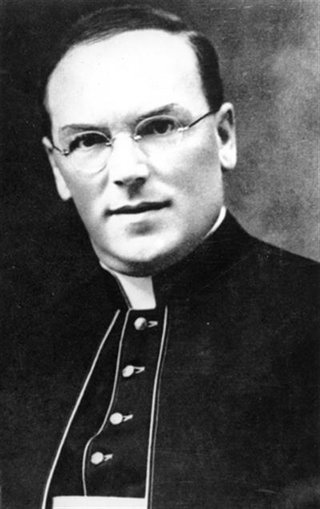Seliger Dr. Carl Lampert

Personalia
Born:
Died:
Profession:
Persecution:
Imprisonment 04.03.1940 - 14.03.1940,
Imprisonment 28.03.1940 - 11.04.1940,
Imprisonment 05.07.1940 - 28.04.1940,
Dachau concentration camp 25.08.1940 - 31.08.1940,
Sachsenhausen concentration camp 31.08.1940 - 15.12.1940,
Dachau concentration camp 15.12.1940 - 01.08.1941,
Banned from the Gau in 1941,
Imprisoned 19.12.1943 - 13.11.1944,
Murdered on 13.11.1944
KZ Number:
Memberships
Curriculum Vitae
After graduating from grammar school in Feldkirch in 1914, Carl Lampert began studying theology at the prince-archbishop's seminary in Brixen shortly after the outbreak of the First World War and was ordained a priest in 1918. His first place of work was Dornbirn St. Martin, where he became chaplain. In addition to his duties as a religious teacher, he was particularly concerned with young people. In the fall of 1930, he went to Rome for further studies. After several years of practice at the Rota Romana, he completed his canon law studies there with a doctorate in canon law (Dr. iur. can.) and was appointed Advocate of the Rota Romana in 1935.
Bishop Sigismund Waitz entrusted him with the establishment of the ecclesiastical court (Offizialat) in Innsbruck in 1935. In 1936, he was also put in charge of the Tyrolia publishing house.
On 15 October 1938, just a few months after the Anschluss, Paulus Rusch was appointed administrator of the Apostolic Administration Innsbruck-Feldkirch, but the Nazis did not recognize him as a bishop. Carl Lampert was therefore appointed provicar (deputy bishop) to the Apostolic Administrator of Innsbruck-Feldkirch on January 15, 1939. This brought him into the sights of the new rulers, in particular the Gauleiter Franz Hofer in Innsbruck, whose merciless hatred of the Church he now took out on Carl Lampert in particular. After three brief stays in prison on March 4, March 28 and June 5, 1940 (each lasting several weeks), he was transferred to Dachau concentration camp on August 25, 1940. The decisive reason for this measure was ultimately Carl Lampert's obituary for the pastor Otto Neururer, who had been murdered in Buchenwald, which was banned but for which he was responsible. among other things: "... after great suffering [torture etc.] ... in Weimar-Buchenwald [reference to concentration camp] ... we will never forget his death [promotion of the idea of martyrdom]." As this was interpreted as a violation of Nazi secrecy regulations, he was arrested again. Carl Lampert's ordeal under the direction of the RSHA in Berlin began when he was sent to a concentration camp.
A few days later, on August 30, 1940, Carl Lampert was transferred from Dachau to the punishment company of the Sachsenhausen Oranienburg concentration camp on the orders of Gauleiter Hofer. Here he had to work in the quarry, endure humiliation, abuse and hunger until he was transferred back to Dachau concentration camp on December 15, 1940. After his release from prison on August 1, 1941, he was ordered by the RSHA to leave the district, meaning he could not return to Tyrol and had to stay in the Pomerania-Mecklenburg district, which he was not allowed to leave without permission.
So the Berlin bishop Konrad von Preysing arranged a place for him in the Carolusstift in Stettin, where he also worked as a hospital and soldiers' chaplain. Now the SS informer Franz Pissaritsch, alias Georg Hagen from Spittal/Drau, is assigned to spy on Carl Lampert and his pastoral activities and his fellow priests in the Stettin area: Chaplain Herbert Simoleit, Provost Ernst Daniel von Stettin, Father Friedrich Lorenz OMI, Father Vincenz Plomka and Father Albert Hirsch. Hagen provided the Gestapo with the relevant incriminating material which, after 10 months of fruitless interrogations, led to the opening of the trial at the Reich Court Martial in Halle/S. on 19 December 1943.
In Halle, the spied-on priests were charged with listening to enemy broadcasts, aiding and abetting the enemy and undermining military strength in accordance with § 21 of the Articles of War. In this first trial, Carl Lampert, Herbert Simolet and Friedrich Lorenz were sentenced to death, permanent loss of honor and confiscation of all their assets on 20 December 1943.
After several weeks of hard imprisonment in Halle (20 December 1943 to 14 January 1944 shackled in chains), Carl Lampert was transferred to the military prison in Torgau on 14 January 1944. Here, from July 24-28, 1944, a second trial is held before the Reich Court Martial. The trial also ends on July 28 with the death sentence. In addition to the previous charges, Carl Lampert was accused of attempted espionage in a third trial from September 4 to 8, 1944. At the third trial on September 8, 1944, the previous sentences against the three priests were also confirmed.
Thus, the priests mentioned were sentenced to death three times. According to eyewitnesses, these trials were pure show trials, the verdicts of which were dictated by the RSHA in Berlin. No one had a fair chance here. To carry out the death sentence, Carl Lampert and the two other priests were taken from Torgau prison to the "Roter Ochsen" prison in Halle/S. in the night from November 12 to 13, 1944, where they were executed by guillotine at 4 p.m. on November 13, 1944, under the pastoral care of prison chaplain Paul Arthur Drossert. Dr. von Wehner's death certificate no. 4569 dated 13 November 1944 states the cause of Carl Lampert's death as "sudden cardiac death - respiratory arrest" and adds "decapitated".
Carl Lampert's urn was initially buried in Halle's Gertrauden Cemetery and was then transferred to his home town of Göfis in 1948, where he found his final resting place. In 1998, a canonization process was initiated, which was concluded with his beatification by Cardinal Angelo Amato. He was beatified on November 13, 2011 in the parish church of St. Martin in Dornbirn.
Places
Persecution:
Place of activity:
Honoring:
Citations
Fritz, Herbert/Krause, Peter (2013): Farbe tragen, Farbe bekennen 1938–45. Katholisch Korporierte in Widerstand und Verfolgung. (ÖVfStg, 2013) S. 399 - 401.
Photo: Dokumentationsarchiv des Österreichischen Widerstands unter www.doew.at; Stand: 26.09.2022.
